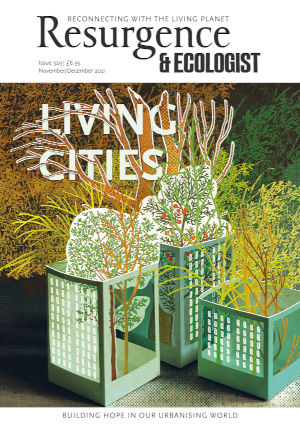Humanity is facing an existential contradiction: we are building an urban future for ourselves, yet urbanisation in its current form is threatening the very future of humanity and the natural world. Urban growth is a seemingly unstoppable worldwide process. Much has been written about this historic trend, but the environmental impacts of an urbanising world are barely discussed.
The 20th century was the age of the ‘great acceleration’. Abundant access to fossil-fuel energy and the rules of neo-liberal globalisation helped to transform the lives and behaviour patterns of billions of people and drove ever-increasing resource use on a finite planet. This period of time could also be dubbed ‘the age of the city’. Thousands of new cities of unprecedented size have sprung up across the face of the Earth and they are widely celebrated as triumphal human achievement, perhaps most notably by Edward Glaeser in his book, The Triumph of the City.
Urban areas are the world’s economic powerhouses, in which 80% of global GDP is being produced. As centres of economic transactions and social interaction, urban-centred communication, transport and trade systems, the world’s cities have a magnetic attraction. They are hubs that have connected humanity as never before, and under current trends three-quarters of an unprecedented human population will be urban by 2050. Modern cities of many millions of people are certainly an astonishing undertaking. They are centres of innovation as well as economic activity, superior education and health services. Investors favour them, since they offer a plethora of services at low per capita cost. Governments like cities because they are a reliable source of tax revenue.
However, as ever-larger and more resource-hungry cities proliferate, we need to ask about how such widespread urbanisation might affect both the wellbeing of city people and the global environment. The number of urban issues is mounting: although cities are built on only 3–4% of the world’s land surface, their ecological footprints cover much of the Earth’s productive land; air pollution problems due to fossil-fuel burning have been widely reported in many of the world’s large cities, with significant consequences for local populations; and the energy demands of cities and associated emissions have major implications for climate breakdown. Cities are ultimately at risk of becoming victims of their own success. They are causing ever-larger global ecological footprints and environmental externalities. As sea levels rise, hundreds of cities across the world, in rich as well as poor countries, will become inundated. Can we create resource-efficient urban systems within the carrying capacity of planet Earth?
A NEW SCIENCE OF CITIES
In recent years there has been an active debate about urban sustainability. It is often argued that in affluent countries city people use resources more efficiently than rural populations. In particular, people in rural areas use more energy in transport and in heating or cooling detached houses. Urban living is therefore claimed to be more sustainable than rural living.
But in developing countries we see a very different picture. Studies from China and India show that people moving from a village to a city will, typically, increase their resource consumption fourfold. The reason is quite evident: traditional rural living there was reliant on locally available renewable resources. Cities, in contrast, offer people easy access to fossil fuels and many other resources and products. Rural–urban migrants will inevitably adopt lifestyles dependent on mineral resources as well as long-distance food and timber supplies. Urban growth in developing countries is therefore a major factor in humanity’s ever-growing global environmental impacts.
As things stand, modern cities rely on a continuous input of resources originating from rural areas across the world. The sustainability of cities is inextricably linked to the sustainability of distant places. China’s meat consumption is a case in point. It has grown nearly tenfold, to 70kg per person per year since 1978 – similar to per capita consumption in Europe, although still lower than US figures. But China matters disproportionately because of its vast population. As China’s own farmland is compromised by soil pollution and the impacts of urban growth, the bulk of the soybeans feeding China’s farm animals now originate from the Amazon basin, and the vast recent fires there are directly connected to the continuing conversion of rainforest into farmland. Urbanisation, then, has become a key factor affecting the health of the Earth system.
The concentration of people in dense urban areas is also implicated in human-to-human disease transmission, such as the Covid-19 pandemic. A new, integrated approach to planetary stewardship is therefore required to address these challenges. How can we address these vital issues in our interconnected world?
URBAN METABOLISM
Across the world, we tend to have little concern about where the resources we use originate and where our wastes end up. We tend to have vague notions about the destination of our solid waste, but know little about the liquid wastes we flush away. The fact is that we all contribute to the hundreds of dead zones in river estuaries across the planet. In addition to the nitrogen, potash and phosphate contained in our food, mineral fertilisers and slurry leaching from farms are also part of the mix, as well as industrial poisons. If we are serious about sustainable urban living, we need to not just decontaminate our sewage, but also ultimately return the nutrients it contains back to the farmland feeding us.
Our collective consumerism has become the main interface between humans and Nature. Our actions are currently turning inherently renewable systems – soils, forests, rivers, coral reefs – into non-renewable systems. These impacts need to be vigorously and positively addressed. The aggregated environmental impacts of an urbanising humanity have to be faced head-on.
Cities have a quantifiable metabolism: energy and materials – carbon, nitrogen, phosphorus, metals, water, industrial products – enter the city from the biosphere and the global economy, and percolate through urban systems before returning to the biosphere in a degraded form. Entropy prevails. The urban metabolism, which currently operates as an inefficient and wasteful linear input–output system, needs to be transformed into a resource-efficient and regenerative circular system.
A new integrated science of urban planning and management is urgently needed. Yet recent books on creating a new science of cities are often concerned mainly with ordering and structuring the intra-urban environment rather than with developing a deeper understanding of the relationship between cities and the living world beyond.
CITIES AS REGENERATIVE SYSTEMS
On a finite planet there are inevitably limits to both economic and urban growth. The only way to overcome notions of ever-greater scarcity is for cities to continually regenerate the living systems on which they rely for their sustenance. As cities become our primary home, we urgently need to learn to comply with the laws of ecology. The planning of new towns and cities, as well as the retrofit of existing ones, needs to undergo a profound paradigm shift, as implied by criteria developed by Barry Commoner:
The four laws of ecology
Everything is connected to everything else. There is one ecosphere for all living organisms, and what affects one affects all.
Everything must go somewhere. There is no ‘waste’ in Nature, and there is no ‘away’ to which it can be thrown.
Nature knows best. The absence of a particular substance from Nature is often a sign that it is incompatible with the chemistry of life.
Nothing comes from nothing. Exploitation of Nature always carries ecological costs, and these costs are significant.
(Adapted from Barry Commoner, The Closing Circle, 1971)
Across the world, different cities are at very different stages of development, and invariably they face different challenges. In Europe, North America and Australia, urban growth is now very limited, and the primary task is to undertake ‘ecological retrofits’ of urban systems. In rapidly urbanising countries in Asia, Africa and South America, urban development needs to be ‘smart from the start’: defined by high standards of resource efficiency, with renewable energy as a key component.
Before the modern era, cities of 1 million people, such as ancient Rome, were the largest human settlements ever built. But today city clusters of 100 million people are already a reality. Nine cities in China’s Pearl River Delta, including Hong Kong, Guangzhou and Shenzhen, have already grown to that sort of dimension. The Chinese government is now envisaging another vast urban cluster called Xiongan, integrating Beijing, Tianjin and Hebei into a city region with some 100 million people. How does this ambition match with China’s well-publicised vision of creating an ‘ecological civilisation’, mainstreaming efficient use of clean energy and utilising advanced environment-friendly processes and materials? ‘Clean’ urbanisation on this scale may be technically possible, but existing examples don’t look promising, with rampant air, water and soil contamination associated with the unprecedented urban-industrial growth that has already occurred in the Pearl River Delta.
Addressing the regional environmental contamination and global ecological footprints associated with modern urbanisation is a historic challenge. On the positive side, it is in cities that dynamic, new ideas are often generated. In the face of the planetary emergency that is upon us, the challenge is to utilise this creativity to rethink cities as regenerative, environmentally beneficial systems, linking the wellbeing of individual urban citizens with humanity’s collective interest in the health of our home planet. Only by mainstreaming renewable energy resources and by protecting and continuously regenerating the ecosystems and soils from which they draw their sustenance can cities become a viable, long-term home for humanity.
Herbert Girardet will be joining us for the Resurgence Readers' Group on 15 November 2021. www.resurgenceevents.org







